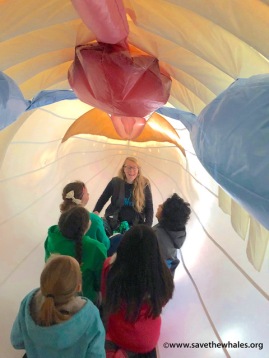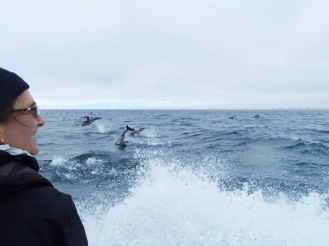You never know where a phone call will lead. A few weeks ago, I called SaveTheWhales.org a nonprofit organization dedicated to preserving and protecting the ocean and its inhabitants. I was interested in gathering information as part of my research for a picture book I’m working on. I was beyond thrilled to speak with the co-founder herself, Maris Sidenstecker II. Not only did Maris generously spend time answering my questions, she agreed to let me share her story. I think you’ll find her as inspiring as I do.
The first thing I noticed while speaking with Maris, was her passion for whales. It was this passion that drove her to start Save The Whales when she was 14, and it’s this same passion that years later, continues to drive her to do all she can to help these beautiful animals survive.
But Maris’ love for animals is not limited to these gentle giants. She has always defended and protected animals of all sizes. As a first grader, she led a team of friends to pick up earthworms in the schoolyard after it had rained, so boys couldn’t step on them. She rescued injured snails and fed them in a terrarium so their shells could mend and then she released them.
Ever since then, Maris has helped as many animals as possible. She grew up in a home with rescued cats, newts, lizards, a fish, turtle, and a dog. As a pre-teen she wrote letters to dog food companies asking them not to slaughter wild horses for dog food. It’s not surprising that Maris wanted to become a veterinarian. However, as often is the case, life happens and plans change.
When Maris was 14 she read an article on a flight from Los Angeles to Boston. It was about a pregnant blue whale who had suffered on a dock for several days before dying. The article, written by Joan McIntyre, the director of a nonprofit organization called Project Jonah, deeply upset Maris, but also ignited her call to action. Maris wanted people to know what was happening to whales, so she designed a T-shirt with a blue whale and three simple words: “Save The Whales.” Maris had no idea that this T-shirt would change her life.

With her own money, she had a dozen Save The Whales T-shirts printed and she gave them away to friends and family. Soon others started asking how they could get one. Maris and her mother (also named Maris) began selling T-shirts through Rolling Stones magazine and donated the proceeds to Project Jonah. She appeared on local TV programs in Los Angeles, attended animal rights fairs and other street fairs with her mother, where they spread the word about the plight of whales by selling “Save The Whales” T-shirts and handing out literature.
In 1977, when Maris was 16, Save The Whales became a non-profit organization. Maris gave presentations to Los Angeles school children about the life of orcas in the wild while she was in high school. Over 40 years later, Maris and her mom are still leading the cause to preserve and protect the ocean and its inhabitants.

Maris went on to become a marine biologist instead of a veterinarian, a decision she made after spending time researching orcas in the wild. Her mother continued to run Save The Whales while Maris was in college. After college, Maris worked at the Catalina Island Marine Institute. She taught groups of school children from all over the western United States about marine life in a hands-on approach. She discovered what an impact this type of learning made on students and knew this method was the best way to inspire students.
In 1988, Save The Whales opened an office in the Los Angeles area. At that time many schools were no longer able to provide field trips for students due to budget constraints. Save The Whales developed an innovative hands-on program called “Whales On Wheels (WOWÔ). Maris and her mom collected permitted whale, otter, and dolphin bones, otter pelts and turtle shells from state and federal agencies. These artifacts had been confiscated from dealers and people attempting to bring whale vertebrae or other artifacts across the border from Mexico or other countries. The artifacts were brought to schools where students were allowed to touch the display items and ask questions about the marine animals
Since its inception in 1988, WOWÔ has traveled all over the country, visiting school children in Alaska, Oregon, Washington, Illinois, Indiana, Ohio, Michigan, Virginia, and California.

Maris believes education is the key to saving the whales, the oceans, and ourselves. To date, Save The Whales has educated over 330,000 students through their hands-on school programs. Her proudest accomplishments are the number of students they have reached with innovative programs and saving marine life from the deadly underwater explosives.
The biggest effort of Save The Whales was their battle to stop the Navy from performing “ship shock” tests in the Channel Islands Marine Sanctuary, a biologically sensitive area off the coast of Southern California. These waters are home to blue, sperm, fin and humpback whales, as well as dolphins, seals and sea lions. If the U.S. Navy had been allowed to go ahead with its plans – which were to test the hull integrity of its new cruisers by detonating 270 underwater explosives over a five-year period – it was estimated that hundreds of thousands of these beautiful animals, as well as other marine life, would have been killed outright. Others would have faced a slow lingering death from damage to their internal organs and hearing.
It was a long battle of ups and downs, but in the end, Save The Whales was victorious. Instead of 270 underwater explosives, the Navy was allowed one detonation farther offshore under the watchful eyes of observers chosen by Save The Whales, to ensure that the area was free of any deep-diving marine mammals.
Maris survived cancer at the age of 28 and believes what we do on land has a direct impact on the environment. The land and sea are connected. Ironically, at this time beluga whales were dying of cancer and Maris used her own story to talk about what was happening to the whales and that we need to pay attention. Over the years, Maris has made many radio and TV appearances, been featured in print media stories, and been cited in books on behalf of Save The Whales, speaking on whale-related issues, such as the harmful effects of captivity on marine mammals.

Maris loves interacting with students and receiving thoughtful letters, artwork, and questions from students all over the world. She hopes future generations will protect the planet, the oceans and whales, and that her story will inspire other young people just as the Joan McIntyre article on Project Jonah inspired her.
Her advice for students is to never give up on their dream. She wasn’t an ace in math or chemistry, and struggled daily with these subjects in college. One advisor actually told her to switch her major. Instead, she switched her advisor. This advisor had no idea who Maris was or how much becoming a marine biologist meant to her. “Follow your convictions,” Maris says. She knew she could do it because she was motivated and focused.
When asked the one thing Maris would change in the world, her answer is, “A compassionate world where the environment and animals are respected. We must realize that our survival and that of the planet depends on our daily actions.”
If you would like more information about Save The Whales please check out their website: https://savethewhales.org/
